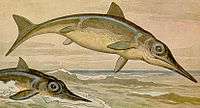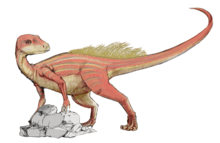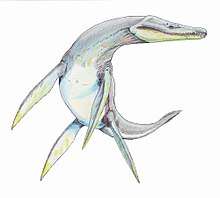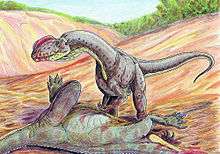Hettangian
The Hettangian is the earliest age and lowest stage of the Jurassic period of the geologic timescale. It spans the time between 201.3 ± 0.2 Ma and 199.3 ± 0.3 Ma (million years ago).[2] The Hettangian follows the Rhaetian (part of the Triassic period) and is followed by the Sinemurian.[3]
| System/ Period |
Series/ Epoch |
Stage/ Age |
Age (Ma) | |
|---|---|---|---|---|
| Cretaceous | Lower/ Early |
Berriasian | younger | |
| Jurassic | Upper/ Late |
Tithonian | ~145.0 | 152.1 |
| Kimmeridgian | 152.1 | 157.3 | ||
| Oxfordian | 157.3 | 163.5 | ||
| Middle | Callovian | 163.5 | 166.1 | |
| Bathonian | 166.1 | 168.3 | ||
| Bajocian | 168.3 | 170.3 | ||
| Aalenian | 170.3 | 174.1 | ||
| Lower/ Early |
Toarcian | 174.1 | 182.7 | |
| Pliensbachian | 182.7 | 190.8 | ||
| Sinemurian | 190.8 | 199.3 | ||
| Hettangian | 199.3 | 201.3 | ||
| Triassic | Upper/ Late |
Rhaetian | older | |
| Subdivision of the Jurassic system according to the ICS, as of 2020.[1] | ||||
In European stratigraphy the Hettangian is a part of the time span in which the Lias was deposited. An example is the British Blue Lias, which has an upper Rhaetian to Sinemurian age. Another example is the lower Lias from the Northern Limestone Alps where well-preserved but very rare ammonites, including Alsatites, have been found.
Stratigraphic definitions
The Hettangian was introduced in the literature by Swiss palaeontologist, Eugène Renevier, in 1864. The stage takes its name from Hettange-Grande, a town in north-eastern France, just south of the border with Luxembourg on the main road from Luxembourg City to Metz.
The base of the Hettangian stage (which is also the base of the Lower Jurassic series and the entire Jurassic system) is defined as the place in the stratigraphic column where fossils of the ammonite genus Psiloceras first appear. A global reference profile (a GSSP) for the base was defined 2010 at the Kuhjoch in the Karwendel in western Austria.[4] The top of the Hettangian stage (the base of the Sinemurian) is at the first appearances of ammonite genera Vermiceras and Metophioceras.
Biostratigraphy
The Hettangian contains three ammonite biozones in the Tethys domain:
- zone of Schlotheimia angulata
- zone of Alsatites liasicus
- zone of Psiloceras planorbis
Palaeontology
†Ammonites
At the end of the Triassic period, the ammonites died out almost entirely. During the Hettangian, however, the "Neoammonites" developed relatively quickly, so that even in the middle Hettangian a large number of genera and species existed.
Crocodylomorpha
| Crocodylomorphs of the Hettangian | ||||
|---|---|---|---|---|
| Taxa | Presence | Location | Description | Images |
| Late triassic to Early Jurassic | USA and South Africa | |||
†Ichthyosaurs
| Ichthyosauria of the Hettangian | ||||
|---|---|---|---|---|
| Taxa | Presence | Location | Description | Images |
| From Hettangian to Sinemurian | Belgium, England, Germany | Among the best known ichthyosaur genera, was smaller than most of its relatives, measuring 2 m (6 ft 7 in) in length. | ||
| Europe | ||||
| From Hettangian to Toarcian | England, Germany | The first Ichthyosaur, T.platyodon discovered by Mary Anning from the Blue Lias at Lyme Regis. Species of Temnodontosaurus were large, exceeding 12 meters (39 feet) in length. | ||
Synapsids
| Non-MammaliaformSynapsids of the Hettangian | ||||
|---|---|---|---|---|
| Taxa | Presence | Location | Description | Images |
Mammaliaformes
| Mammaliaformes of the Hettangian | ||||
|---|---|---|---|---|
| Taxa | Presence | Location | Description | Images |
†Ornithischians
| Ornithischians of the Hettangian | ||||
|---|---|---|---|---|
| Taxa | Presence | Location | Description | Images |
| From Hettangian to Sinemurian | Upper Elliot Formation, Lesotho and Cape Province, South Africa | Considered the most basal member of the family Heterodontosauridae | ||
| From Hettangian to Sinemurian | Lesotho | As the only fossil known of it is a partial jawbone with three teeth, Fabrosaurus is a nomen dubium. | ||
| Upper Elliot Formation, Cape Province, South Africa | A small, fleet-footed ornithischian that reached a maximum size of about 3 feet. The hand of Heterodontosaurus had five fingers, two of which seem to be opposable, allowing Heterodontosaurus to grasp and manipulate food.
Another interesting feature is the specialization of teeth which gave rise to the animal's name. At the front of the jaw beside the beak were small teeth likely used for chopping off leaves and stems. | |||
| From Hettangian to Sinemurian | Upper Elliot Formation, Orange Free State, South Africa | A heterodontosaurid ornithischian | ||
| From Hettangian to Sinemurian | Upper Elliot Formation, Cape Province, South Africa | A small herbivore dinosaur despite long canines it sported in its jaws; due to this unique characteristic it is very clearly allied to Heterodontosaurus | ||
| From Hettangian to Sinemurian | Charmouth, West Dorset, England; Kayenta Formation, Arizona, USA | A genus of quadrupedal, lightly plated, herbivorous dinosaur about 4 meters (13 feet) long | ||
| Arizona, USA | A bipedal armored herbivore, was around 1.3 m (4 ft 3 in) long, 0.5 m (20 in) tall at the hips, and weighed 10 kg (22 lb). | |||
| From Hettangian to Sinemurian | Stormberg Series Formations, South Africa, Lesotho | A primitive ornithischian, about 2 meters long. The proportions of the posterior limbs show differences with those of Lesothosaurus, and reveal a lower ability to run | ||
†Plesiosaurs
| Plesiosauria of the Hettangian | ||||
|---|---|---|---|---|
| Taxa | Presence | Location | Description | Images |
| Lower Hettangian | Blue Lias Formation, England | A genus of basal, non-neoplesiosaurian, plesiosaur | ||
| Lower Hettangian | Barrow-upon-Soar, Leicestershire, England | A genus of rhomaleosaurid sauropterygian carnivorous reptile. It was about 7 m long. | ||
| Earliest Hettangian | Blue Lias Formation, England | A genus of small rhomaleosaurid sauropterygian. | ||
| Earliest Hettangian | Blue Lias Formation, England | A proportionally long-necked plesiosaurian. A study found it to be the basalmost known plesiosauroid. | ||
| Earliest Hettangian | Blue Lias Formation, England | A genus of large rhomaleosaurid sauropterygian. | ||
| Upper Hettangian | Harbury, Warwickshire, UK | A genus of rhomaleosaurid sauropterygian carnivorous reptile. It was about 4.5 m long. | ||
| Lower Hettangian | Blue Lias Formation, England | A genus of rhomaleosaurid sauropterygian carnivorous reptile. | ||
| Lower Hettangian | Blue Lias Formation, England | A genus of small basal pliosaur, possibly the earliest pliosaurid. It measured 1.5–2 m. | ||
†Theropoda
| Theropoda of the Hettangian | ||||
|---|---|---|---|---|
| Taxa | Presence | Location | Description | Images |
| Hettangian to Pliensbachian | Elliot Formation, Eastern Cape Province, South Africa | This species was a small to medium-sized, lightly built coelophysoid theropod, that could grow up to 3 m (9.8 ft) long. | ||
| Hettangian | Lavernock Point, Blue Lias Formation, Britain | A genus of primitive neotheropod dinosaur. Despite its relatively young age it is considered to be the most basal coelophysoid. | ||
| Hettangian | Elliot Formation, Eastern Cape Province, South Africa | A genus of dilophosaurid theropod dinosaur. It is estimated to have measured between 5.5 and 6.5 meters in length. | ||
| Hettangian | Lower Lufeng Formation, Yunnan, China | Eshanosaurus is most likely a therizinosaur, and its presence in the early Jurassic has important implications for the evolutionary history of coelurosaurs, notably, that large portions of the coelurosaur fossil record remain missing | ||
| Rhaetian to Hettangian | Normandy, France | A small to medium-sized, moderately-built, coelophysoid theropod that could grow up to 3 m long. Lophostropheus is one of the few dinosaurs that may have survived the Triassic–Jurassic extinction event. | ||
| Hettangian | Shawan Member, Lufeng Formation, Yunnan, China | Sinosaurus was a basal tetanuran theropod. It measured approximately 5.6 meters in length. Formerly known as "Dilophosaurus" sinensis. | ||
| Hettangian | Fengjiahe Formation, Yunnan, China | Possibly synonymous with Sinosaurus sinensis. Known from a partial skull, similar to Sinosaurus', especially its contemporary, robust S. sinensis species/morphotype, but it's even more robust with somewhat different crests. | ||
| Hettangian | Lufeng Formation, Yunnan, China | A coelophysid. | ||
See also
- Triassic-Jurassic extinction event
- Komlosaurus carbonis
References
Notes
- http://www.stratigraphy.org/index.php/ics-chart-timescale
- Benton, Michael J. (2012). Prehistoric Life. Edinburgh, Scotland: Dorling Kindersley. pp. 44–45. ISBN 978-0-7566-9910-9.
- For a detailed geologic timescale, see Gradstein et al. (2004)
- GSSP Table Archived 2012-11-15 at the Wayback Machine
Literature
- Gradstein, F.M.; Ogg, J.G. & Smith, A.G.; 2004: A Geologic Time Scale 2004, Cambridge University Press.
- Renevier, E.: Notices géologiques et paléontologiques sur les Alpes Vaudoises, et les régions environnantes. I. Infralias et Zone à Avicula contorta (Étage Rhaetien) des Alpes Vaudoises Bulletin de la Société Vaudoise des Sciences Naturelles 8, p. 39-97. (in French)
External links
- GeoWhen Database - Hettangian
- Lower Jurassic timescale, at the website of the subcommission for stratigraphic information of the ICS
- Stratigraphic chart of the Lower Jurassic, at the website of Norges Network of offshore records of geology and stratigraphy









